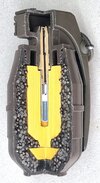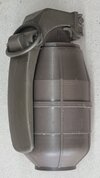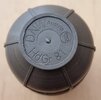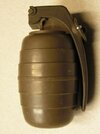pzgr40
Well-Known Member
Cutaway model of an Austrian Handgrenade (HdGr) 81, designed by the Glock company and produced by DNW (Dynamit Nobel Wien).
The grenade body consists of a matrix of 4000 hardened steel balls with a diameter of 2.5 mm, cast in synthetic resin and covered with green PVC. A special feature of this hand grenade is that a loose splinter ring is incorporated in the explosive charge, which ensures that the propagation of the detonation is controlled and the splinter effect is all-round.
In a test setup in which a round wall with a diameter of 5 meters was set up and the grenade was detonated in the middle, each square meter of the wall had at least 20 hits from splinters.
Because the splinter effect of the HdGr.81 does not extend beyond 20, the grenade is suitable for use as both a defensive and offensive hand grenade. Because the grenade has no metal parts, the grenade is insensitive to corrosion and the moving parts of the fuze are not sensitive to sand (think of use in the jungle or desert). The HdGr.81 can be used at temperatures between -40 and +70 degrees Celsius.
The fuze works according to the 'mousetrap' principle; a spring-loaded rotating firing pin is fixed by the spoon until the grenade is thrown and the spoon is released. When thrown, the spring-loaded firing pin will push the spoon away and the firing pin will hit the primer, which in turn ignites the pyrotechnic fuse. The flame from the fuse is guided into the detonator, which in turn detonates the main charge in the grenade body.
The grenade described here is, however, different from the grenades of this type described in the literature (Jane's infantry weapons), which have a rounder base; the SHG 60 which also has a loose splinter ring in the explosive charge and the Hdgr 80 which has a ‘stepped’ outer casing. However, both use the same fuze body and spoon made entirely of PVC.
Data:
Height: 115 mm.
Diameter: 60 mm.
Weight: 575 grams.
Explosive charge: 75 grams
Fuze delay: 4.5 plm. 0.5 sec.
Greetings, DJH
The grenade body consists of a matrix of 4000 hardened steel balls with a diameter of 2.5 mm, cast in synthetic resin and covered with green PVC. A special feature of this hand grenade is that a loose splinter ring is incorporated in the explosive charge, which ensures that the propagation of the detonation is controlled and the splinter effect is all-round.
In a test setup in which a round wall with a diameter of 5 meters was set up and the grenade was detonated in the middle, each square meter of the wall had at least 20 hits from splinters.
Because the splinter effect of the HdGr.81 does not extend beyond 20, the grenade is suitable for use as both a defensive and offensive hand grenade. Because the grenade has no metal parts, the grenade is insensitive to corrosion and the moving parts of the fuze are not sensitive to sand (think of use in the jungle or desert). The HdGr.81 can be used at temperatures between -40 and +70 degrees Celsius.
The fuze works according to the 'mousetrap' principle; a spring-loaded rotating firing pin is fixed by the spoon until the grenade is thrown and the spoon is released. When thrown, the spring-loaded firing pin will push the spoon away and the firing pin will hit the primer, which in turn ignites the pyrotechnic fuse. The flame from the fuse is guided into the detonator, which in turn detonates the main charge in the grenade body.
The grenade described here is, however, different from the grenades of this type described in the literature (Jane's infantry weapons), which have a rounder base; the SHG 60 which also has a loose splinter ring in the explosive charge and the Hdgr 80 which has a ‘stepped’ outer casing. However, both use the same fuze body and spoon made entirely of PVC.
Data:
Height: 115 mm.
Diameter: 60 mm.
Weight: 575 grams.
Explosive charge: 75 grams
Fuze delay: 4.5 plm. 0.5 sec.
Greetings, DJH




